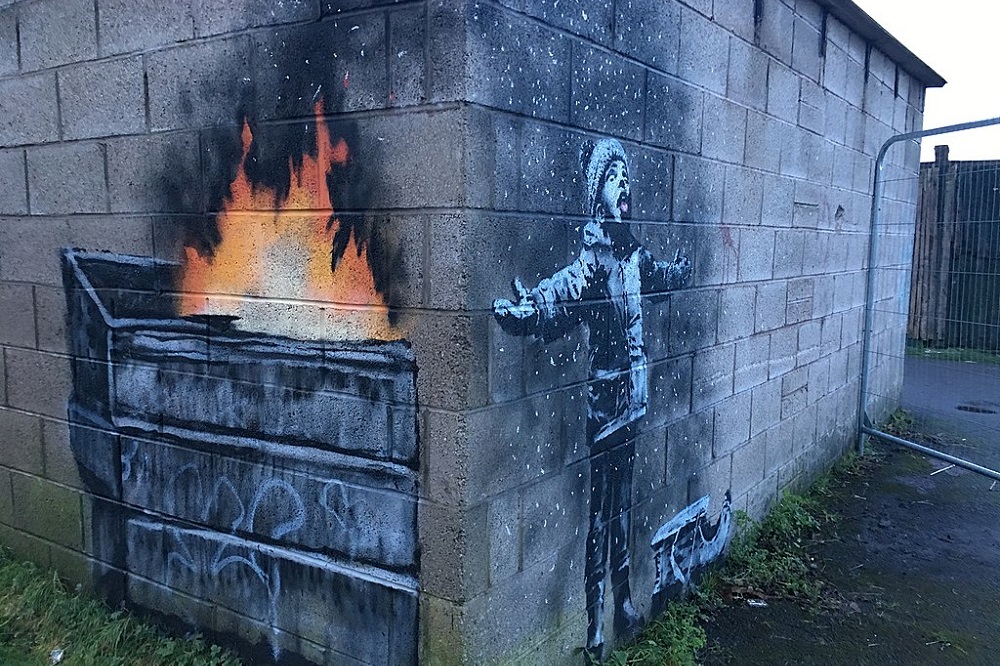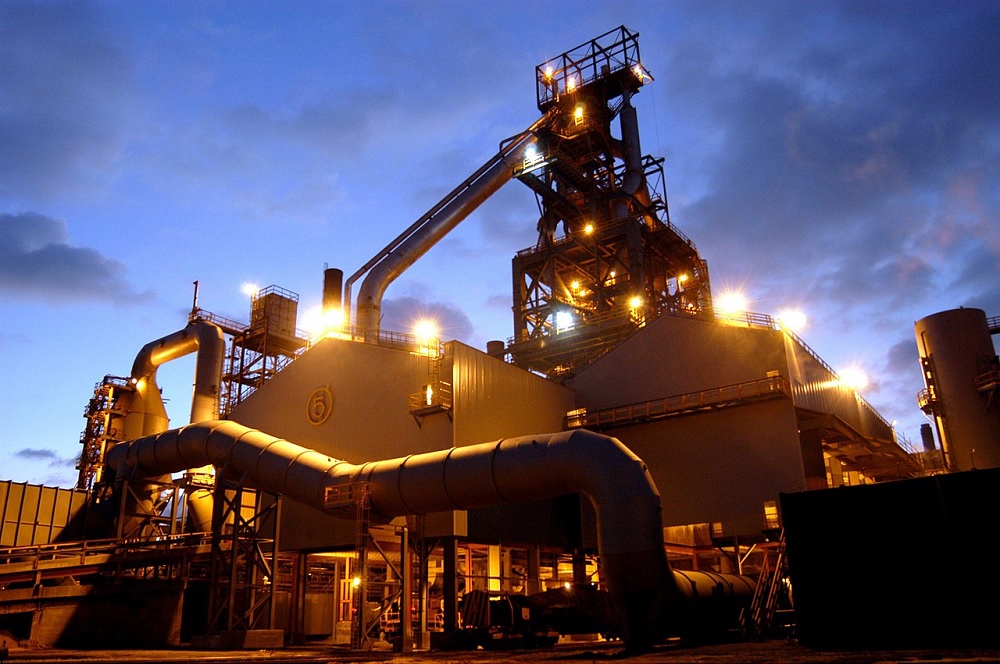Stuck in Port Talbot: ‘where clouds are made’

Debbie Marshall
In the early 1990s, Tracey Emin, not yet a world-famous and very rich artist, told her ex-boyfriend, artist, musician and poet Billy Childish, that he and his art were stuck! Stuck! Stuck! He turned her words into a poem and Stuckism became an art movement. Emin’s words and the imagined scene between her and Childish float into my mind on occasion, and so it is on a Sunday afternoon in Port Talbot in South Wales, on the brink of winter in 2021.
I am pressing my face to a plate glass window, trying to get a glimpse of a disembodied Banksy artwork sitting inside what looks like an empty shop called… Banksy’s. Disembodied, because it was removed from its original location on the corner of steelworker Ian Lewis’s garage in the Taibach area of the town, 2.5 tonnes of concrete blocks cut away and encased in a four-tonne metal frame, hoisted on the back of a lorry and given a police escort to its new home, next to Port Talbot’s redeveloped bus and train station.
Stuck, because that’s how it is now, behind a sheet of glass, ghost-like and almost impossible to see when the sun is out and all you can see is your own reflection and shadow falling through into the dark interior.
Heavy industry
And the feeling of stuck is upon me as well, because I’m in Port Talbot and it’s Sunday and I don’t belong here but I recognise here, this small town on a Sunday. Not just any small town but a rural, coastal small town that is dominated by heavy industry, just like the Northern shipbuilding town of Barrow-in-Furness where I was born and partly raised. Barrow is not on the way to anywhere, you don’t even pass through it or by it as you do with Port Talbot, it is literally at the end of the road – the A590, sometimes known as the longest cul-de-sac in the world.
Stuck was a way of life there in the late 1970s and early 80s, and probably still is. I don’t know, I haven’t been back for a hundred years, or so it seems. Tracy Emin too, grew up in the 70s and 80s, in a seaside town in Kent, where it was hard to escape from the things that happened to you, and who you were and how others saw you, and from the gravitational hold of the town. Emin is circling back to Margate – I’m not sure I could do the same.

And yet, here I am, a hundred years later, in essentially the same place. Here, in the almost empty, wide open, block paved space of the bus station, wind-whipped hair in my eyes and dazzled by the sudden brightness of the sun as the clouds break blue overhead after all that rain. The odd zigzag angles of the not-long completed and way too big entrance to the tiny two-platform station mirror the criss-cross paving stones and the yellow crosshatch no-parking zone.
Station announcements echo in the air though no-one is waiting on the platforms, a few cars swish past on Talbot Road and the man at bus stand no 2 shouts at everyone and no-one. Maybe the bus is late, maybe he’s had one too many at the Red Lion pub over the way, or maybe he’s stuck too, in one way or another.
Gulls
I sit down on a wooden bench and watch the gulls balance and glide on the eddies and the uplifts. It’s a reminder that Aberavon Beach is only minutes away, a giant’s hop and skip over the streets and houses, many of them built for the workers in the steelworks that dominates the town, visually, environmentally, economically, psychologically.
If you go to Aberavon Beach, you can’t miss the plant sprawling at one end of this beautiful stretch of coastline, popular with surfers, dog walkers and families, and I can see it from where I sit, a few miles away in the gap between the pub and the station buildings, steam rising from the towers that reach up into the broken clouds and blue sky.
Banksy’s graffiti image, Season’s Greetings, which appeared in the town just before Christmas in 2018, captures this dominance. A child, rendered mainly in monochrome, dressed in winter gear of wellies, anorak and woolly bobble hat, sledge at his or her feet, stands with arms outstretched, face turned up to the sky, mouth open and pink tongue extended to catch falling snow. Look around the corner and you realise it isn’t snow.
A fire burns in a skip, almost white at the centre through yellow, orange and red, and from it, ash, soot, flecks of pollution float in the air and into the mouth of the child. Any Port Talbot resident in the streets around the steelworks will recognise this image as part of their lived reality, with the notorious pink dust that settles on the clothes that they hang out to dry.
In the Instagram video released by Banksy to authenticate and expand on the piece, a camera rises over its original site in Taibach and we see over the rooftops to where the largest steelworks in the UK hunkers down on the near horizon. There is something almost organic about this kind of heavy industry. It lives and breathes, the way a big city lives and breathes, in and of itself.

Growing up in Port Talbot and a vocal champion of the town, actor Michael Sheen saw the plant as ‘dark and malevolent, like this sort of monster sitting there down by the sea,’ and believed that clouds were made there, from the steam and smoke that rose from the chimneys and pipes.
After dark though, things were, and still are, different. The rusty, dirty, polluting monster is transformed into a dystopian beauty, all twinkling lights, steam and flames glowing orange, blue and white ballooning into the night sky from tall towers. There is a rumour that film director Ridley Scott witnessed this other-worldly vision as he drove past on the M4 at night and it made its way into the opening scenes of Bladerunner, Scott’s 1982 neo-noir science fiction film classic.
The same towers rise into the night sky, orange flames plume and mushroom upwards into the dark, but here the lights are part of a sprawling future Los Angeles, reflected in the disembodied eye that fills the screen. And any Star Wars fan standing on Aberavon Beach would surely make a similar imaginative leap, from the cranes crouching like humpbacked creatures on the edge of the sands to one of the most famous images of the Star Wars universe, the towering, four-legged Imperial Walkers, all-terrain combat vehicles that stride across deserts and frozen wastelands.
Creative
The Banksy piece has sparked a more local creative response, a community-based, collaborative project, ARTWalk Port Talbot. This guided street art trail of Port Talbot, initiated by Cardiff-based actor, playwright and theatre director Paul Jenkins and funded by Heritage Lottery, starts with the Banksy in its current setting and winds through the local streets to showcase vivid images in unlikely spaces, created by a mix of local and national street artists.
There is a sense here that there might be different possibilities for small towns and people that carry heavy burdens, ways to feel less stuck on a Sunday or any other day, through community, collective projects and creativity.
Global recognition and huge sums of money exchanging hands are not the only ways to measure the value of art – my guess is that Banksy would agree.
Support our Nation today
For the price of a cup of coffee a month you can help us create an independent, not-for-profit, national news service for the people of Wales, by the people of Wales.






Sadly, Ridley Scott wasn’t inspired by Port Talbot after dark. I’m pretty sure Michael Sheen asked him. To my lasting disappointment, the Blade Runner connection was an urban myth. Likewise Star Wars’ Imperial Walkers. Even though a tour guide on a bus in San Francisco did say they were indeed inspired by the cranes in the docks; albeit in the Port of Oakland not the Port of Talbot.
Of course, now that fake news is believed by half of America we may as well continue to proclaim Port Talbot as a major ‘center’ of artistic inspiration.